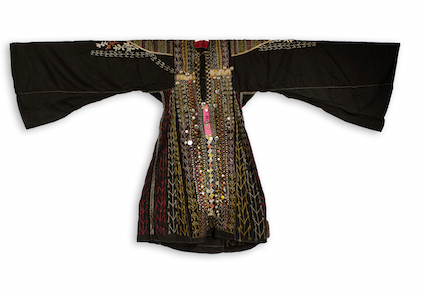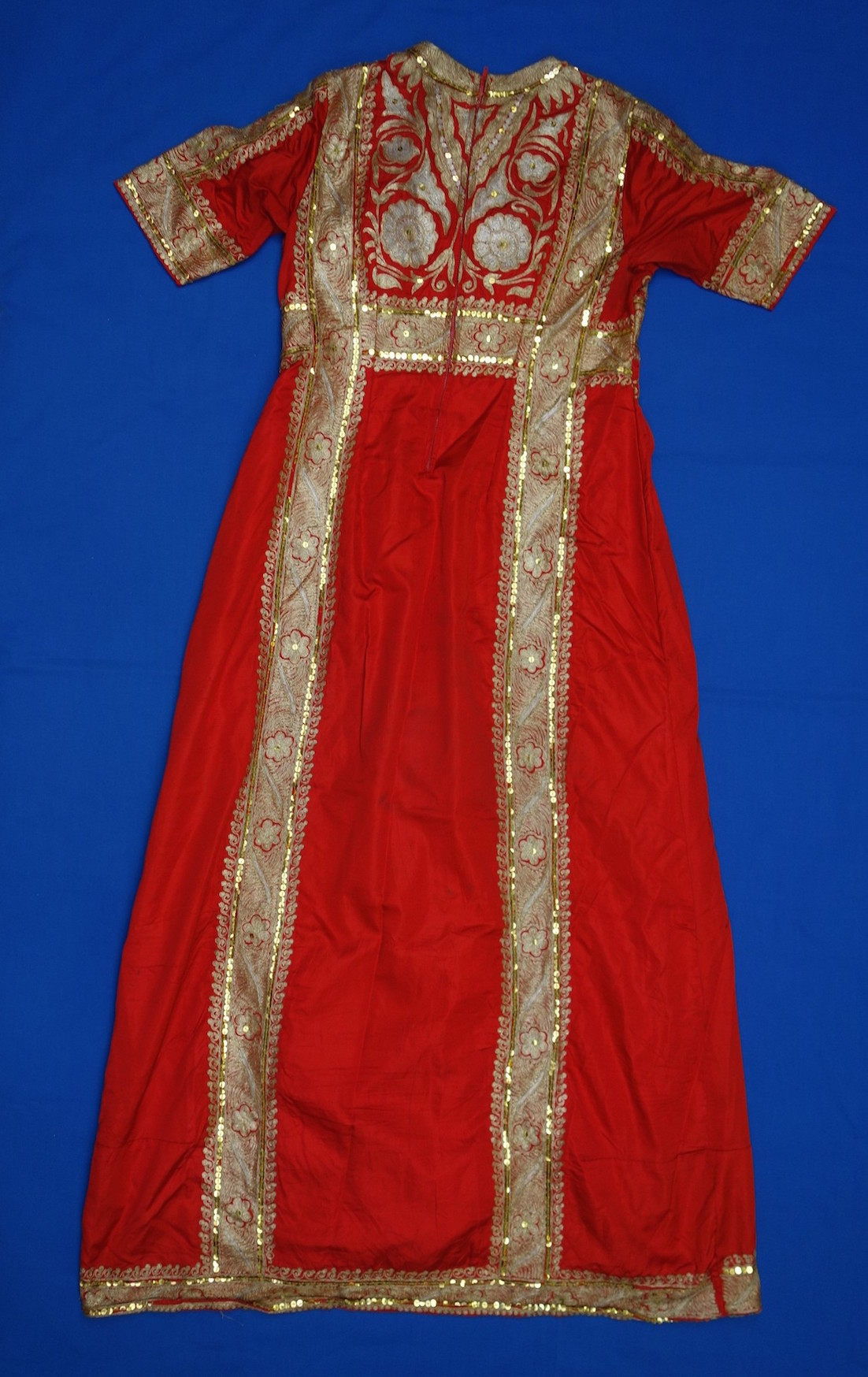 Woman's dress from Yemen. TRC 2012.0382. This dress was worn by a Bedouin woman from the north of the country.There is a cliché image of clothing from the Arabian Peninsula of men wearing long, white dresses with checked cloths on their heads and women wearing black, billowing cloaks with black head and face coverings. But the truth is very different and much more complex, visually attractive and, indeed, colourful!
Woman's dress from Yemen. TRC 2012.0382. This dress was worn by a Bedouin woman from the north of the country.There is a cliché image of clothing from the Arabian Peninsula of men wearing long, white dresses with checked cloths on their heads and women wearing black, billowing cloaks with black head and face coverings. But the truth is very different and much more complex, visually attractive and, indeed, colourful!
This exhibition package, which is for hire by suitable museums or institutes, is inspired by the Encyclopedia of Embroidery from the Arab World (London: Bloomsbury 2016) and the exhibition ‘Embroidery from the Arab World’, mounted at the Textile Research Centre (TRC) in Leiden, The Netherlands, in 2010-2011. The objects included in the basic exhibition package derive from the extensive holdings of the TRC (see the TRC online catalogue). In consultation with the TRC the exhibition can be expanded with objects from the host museum or institute.
Introduction
But to understand the diversity and colour of the exhibition package it is helpful to look at the Arabian Peninsula itself. Basically it is a vast region that varies in climate and geography from snowy mountains, sub-tropical (and humid) beaches to dry and desiccated deserts. The coastal regions have been favourite trading spots for thousands of years (literally), while at the same time trade in parts of the interior was dependent on camel caravans moving slowly from one oasis to another. Although transportation and communications have dramatically changed over the last few decades, the isolation and vastness of the peninsula remain an ever present feature of life.
The exhibition, Flowing Robes, reflects the traditional forms of dress and accessories for men, women and children living under these vary varied conditions in the Arabian Peninsula. Most of the garments and accessories date from the 20th century and include items from Oman, Saudi Arabia, the UAE as well as Yemen. The garments come from the northern Saudi Arabia to the Yemeni island of Socotra in the Indian Ocean, which was an important stop-over for merchants travelling between India, the Arabian Peninsula, eastern Africa and the Mediterranean region. The garments and jewellery on display will reflect local forms, as well as national and international cultural, economic, political, religious and social differences. The garments reflect a variety of social and economic positions, as well as decorative techniques. For example, there will be a dress worn by a Saudi princess at a royal wedding in 1984 (TRC 2005.0071). The cloth for this garment was especially woven in India in gold and silver brocade and has the woven inscription “Made for the Saudi Royal Family”, in Arabic, along the lower edge of the garment (a modern example of tiraz, an inscribed textile). Other garments in the exhibition were made by professional male tailors, as well as by the women for themselves and family members. The decorative techniques include woven, printed as well as embroidered forms.
Face veiling
An important form of a gender, cultural and ethnic indicator is the face veil, which is worn by many (but not all) women in the Arabian Peninsula. Part of the exhibition is used to discuss the various different forms that indicate if a woman is an urban or village Arab, Baluch, Bedouin (and which tribe), or indeed comes from a totally different group. Basically the exhibition describes what are the (technical) differences between a batullah, (Arab) burqa, litham, miqnab, niqab and a qina; historically these are very different forms of face veils that reflect the cultural, religious and social status of the wearer.
Ihram and the Hajj
The religious aspect of the exhibition is reflected in a look at what is worn by men and women while on Hajj (ihram dress), the annual pilgrimage to Mecca. It is one of those moments when the rules for what men wear are much stricter than those applied to women. It is worth noting, for example, that according to some schools of thought it is not necessary for Saudi women to wear face veils while wearing ihram, but by law they have to if they are in public under any other set of circumstances.
Men and colour
As noted earlier, there is a cliché image of Arab men wearing white gowns with white or checked headcloths, yet this is a relatively recent development. Prior to the mid-1950s Arab men, especially from among the various royal families, wore patterned and coloured gowns, coats, headcloths and so forth. Some of these garments came from Europe, Syria, India as well as China. It is with the growing influence of conservative groups that plain white or pastel coloured garments became the acceptable wear for men. There are various modern (male) fashion designers who are trying to change the colour (literally) of men’s wear in the Arabian Peninsula. These include the Saudi Arabian designer Yahya al-Bishri.

The current unrest in many parts of the Arab world has meant that the source of materials and garments in many countries, notably from Syria and Yemen, has ceased. The importation of cheaper, Asian textiles (especially those from China) is causing many traditional forms to vanish, and creating the opportunity for other dress norms and forms to be adopted. One such example are the colourful outdoor coverings and face veils that used to be worn by married women in Sana`a, the capital of Yemen. Recent religious and political unrest in the region, however, has meant there is a general move towards wearing ‘Saudi black’ – which is safer, but goes against the desire by many women to wear bright colours. Some regard the use of black as an unacceptable face of foreign influence upon their own culture. This aspect of Arabian Peninsula clothing will be discussed and explored at various points within the exhibition.
Silver jewellery and bracteates
Another aspect of the exhibition will be the presence of silver jewellery and bracteates, which were made in Oman and Yemen for both Bedouin and urban dwellers. Many of these forms have now been replaced by Indian gold jewellery that appeals to a modern audience. Part of the story of silver jewellery from this part of the world is closely linked to Austria and in particular the Maria Theresa thaler, a silver coin that is still being made and used as an international trade coin. Many of these coins still bear the date 1780, the year in which the Empress Maria Theresa died.
Exhibition structure
The exhibition is divided into five main sections:
- Saudi Arabian dress for men and women
- Ihram: Men and women’s clothing during the Hajj
- Yemeni dress for men and women
- UAE dress for men and women
- Omani dress for men and women
There will also be a small number of snapshots that expand upon a particular general theme:
- Snapshot: abas, abayehs and bishts.
- Snapshot: basic headwear for men (headcloths and headropes)
- Snapshot: face veils for women
1 Saudi Arabian dress for men and women
- Northern
- Wadi Dawasir
- Central
- Najd (Bedouin, urban)
- Riyadh (urban, royal family)
- Eastern
- General
- Snapshot: outfit presented to the first American dentist in Saudi Arabia - by a member of royal family (1950’s)
- Western
- Hijaz (Bani Malek, Bani Salek, etc)
- Southwestern
- Northern Asir (Bani Malek)
- Southern Asir
- Flower men of Asir
- Abha region dress
2 Ihram: Men and women’s clothing during the Hajj
- Men’s garments (two different ways of wearing ihram)
- Women’s garments (five different outfits from around the Islamic world)
3 Yemeni dress for men and women
- Northern (indigo garments for men and women, Bedouin forms)
- Central (mountainous regions)
- Sana`a (urban, Saudi influence)
- Tihama (four different types representing different villages and towns, African influence)
- Wadi Hadramawt (various village and Bedouin wedding dresses)
- Socotra (Indian influence)
- Snapshot: Men’s gold embroidered dagger belts (hand embroidered)
4 UAE dress for men and women
- Khalijia style dress for women
- Different thobs and headgear for men from the six different monarchies
- Girl’s garments from the UAE
5 Omani dress for men and women
- Northern (Arab, Baluch, Sohar)
- Muscat (Arab, Lawati, modern urban)
- Nizrah (Western)
- Eastern (Ibri, Sur)
- Southern (Dofar, mountain)
- Snapshot: men’s headgear (caps and turbans)
- Snapshot: a fashion designer’s version of a Dofar wedding dress for the Muscat audience (beaded outfit)
Technical information
Size of exhibition: minimum 150 square metres. The size can be expanded dependent on the wishes of the host.
Number of objects: c. 150 items ranging in size from a pair of sandals to over-garments made of 12 m of material. The items include a number of complete and spectacular outfits that can be fitted onto mannequins (not included in the package).
Range of dates: The pieces are mainly 20th century in date
Illustrative items: Photographs
Lighting: most of the items are 20th century and made with synthetic dyes, and it will not be necessary to keep to a strict 50lux lighting situation.
Display: the silver jewellery should be behind glass, but most of the TRC garments and outfits can be displayed on podiums, behind waist level barriers, etc. There should be a ‘do not touch’ policy.
Intended public: anyone interested in Arab culture, textile techniques, embroidery (history and techniques), art and design groups, etc. The exhibition contents can be changed and adapted to the needs of the host's public.
Related activities: Workshops on Saudi Arabian embroidery, Yemeni embroidery
Publications: Embroidery from the Arab World (Primavera Press, Leiden 2010); Encyclopedia of Embroidery from the Arab World (Bloomsbury Press, London, 2016), both by Dr. Gillian Vogelsang-Eastwood, director TRC. A range of suitable postcards are also available. These are based on items in the TRC Collection. Available from: Summer 2017
Length of loan period: three to four months (longer is possible if necessary)
Loan fee: €25000
Courier: flight (KLM, economy) depending on distance, plus accommodation and per diem in Toronto.
Transportation of objects: (if a specialist art courier is used), c. €12000










